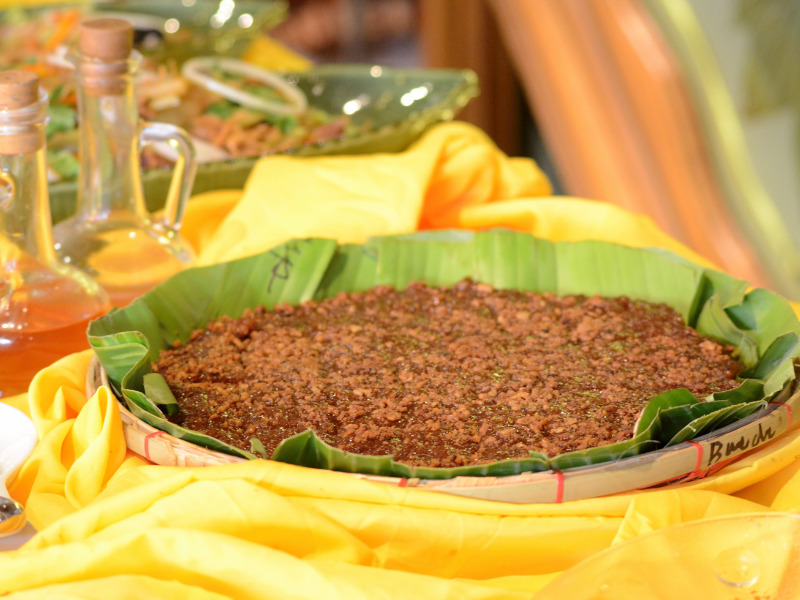Biko Recipe
Are you ready to experience the sweet and sticky magic of biko? This biko recipe is your ticket to exploring the delightful flavors of biko. Our step-by-step instructions and tips will how to cook biko to impress your friends and family.
Get ready to indulge in biko’s sweet and nutty flavors: a dessert that’s easy to make and hard to resist!
What Is Biko?
Biko refers to a traditional Filipino dessert or kakanin made from glutinous rice, coconut milk, and brown sugar.
You can make biko by cooking glutinous rice in coconut milk and brown sugar until it becomes sticky and chewy. Locals usually serve it during holidays or festivals in the Philippines.
The dish boasts a rich and sweet flavor, with the coconut milk providing a creamy and slightly nutty taste. Meanwhile, the brown sugar adds a caramel-like sweetness.
Cooks usually top it with latik, a mixture of coconut milk and sugar cooked until it forms a caramel-like sauce. They also sometimes sprinkle it with toasted sesame seeds.
Biko Origin

People believe the name “biko” originated from the Malaysian word “beras pulut,” which means glutinous rice. Glutinous rice is a common ingredient in many Southeast Asian cuisines, so similar rice desserts likely inspired the dessert.
Biko is also closely related to other rice-based desserts in the Philippines, such as suman and maja blanca. Kakanin refers to Filipino rice cakes made from glutinous rice, usually wrapped in banana leaves.
Filipinos love to serve biko as a snack or dessert at any time of the day. Today, the dish remains a beloved and iconic dessert in Filipino cuisine. You can find it in many Filipino households and restaurants in the Philippines.
Biko Cooking Tips

Here are some cooking tips to help you make the perfect biko:
1. Soak the glutinous rice.
Before cooking, soak the glutinous rice in water for at least 30 minutes. Doing so helps cook it more evenly. It also prevents the dish from becoming too dry.
2. Use the right amount of water and coconut milk.
The ratio of water to coconut milk is essential when cooking rice.
A great rule of thumb: use one part rice for one part coconut milk and one part water. You may need to adjust the amount of water depending on the type of rice and your desired level of stickiness.
3. Don’t overcook the rice.
Cooking time can vary depending on the type of glutinous rice and the cooking method.
Generally, you must cook the sticky rice until it’s tender and has absorbed all the liquid. However, it must retain its shape and chewy texture.
In addition, be careful not to overcook the rice because this can result in a mushy and unappetizing dessert.
4. Use a non-stick pan or lined baking dish.
Biko can stick to the bottom of the pan, so it’s best to use a non-stick baking pan. Alternatively, line a baking dish with parchment paper or banana leaves to prevent sticking.
5. Make delicious latik.
Cook the coconut milk and sugar slowly and stir it constantly to prevent burning. Do this until the mixture thickens and turns a caramel-like color. But please be careful not to overcook it because it can lead to a hard and grainy texture.
How to Serve Biko

Cook biko to the next level by topping it with latik― a creamy and sweet coconut sauce. Then, sprinkle it with toasted sesame seeds for a crunchy and nutty finish.
And let’s not forget about the presentation. Traditionally, locals serve it on banana leaves, which adds a pop of color to your plate. It also enhances the flavor of this beloved dessert.
You can also enjoy it alone or pair it with your favorite drinks like tea, coffee, milk, or iced tea.
How to Store Biko
Don’t let your biko go to waste – store it like a pro with these tips.
After indulging in this sweet and sticky dessert, allow it to cool to room temperature before transferring it to an airtight container.
If you can resist the temptation to finish it all in one go, you can store your biko at room temperature for up to two days or in the refrigerator for up to a week.
But, if you want to keep it for even longer, pop it in the freezer for up to a month. When you’re ready to enjoy it again, thaw it at room temperature and heat it on the stove, oven for baking, or microwave with a small amount of water.
Biko Recipe
Biko Recipe
Ingredients
- 3 cups glutinous rice
- 2 cans coconut milk (13.5 oz each)
- 3 cups water
- 2 cups brown sugar
- 1/2 tsp salt
- banana leaves optional
- 1/2 cup sesame seeds optional
Instructions
- First, clean the rice. Then, soak the glutinous rice in water in a large bowl for at least 30 minutes.3 cups glutinous rice
- Next, mix the soaked rice, water, coconut milk, brown sugar, and salt in a large pot. Bring the mixture to a boil over medium heat.3 cups glutinous rice, 2 cans coconut milk, 3 cups water, 2 cups brown sugar, 1/2 tsp salt
- Bring the heat to low and allow the mixture to simmer. Slowly stir it until the sticky rice absorbs the liquid or until it becomes tender and sticky.
- Next, toast the sesame seeds in a dry pan over medium heat. Remove them from the heat once they look brown and smell fragrant. Set aside.1/2 cup sesame seeds
- Once the rice is cooked, remove it from the heat and let it cool down slightly.
- If you are using banana leaves, wash them and wipe them dry. Cut them into eight-inch squares and place them on a platter or tray.banana leaves
- Spread the cooked rice evenly on the banana leaves, pressing down gently to make it compact.
- Then, cook the remaining coconut milk over low heat until it thickens and turns a caramel-like color. Stir constantly to prevent burning the latik.
- Pour the latik over the rice, spreading it evenly to cover the surface. Then, sprinkle the dish with the toasted sesame seeds.
- Allow the biko to cool to room temperature before serving.

Cuisine: Filipino
Prep Time: 30 minutes
Cook Time: 1 hour
Total Time: 1 hour 30 minutes
Servings: 8-10
Ingredients
3 cups glutinous rice
2 cans of coconut milk (13.5 oz each)
3 cups water
2 cups brown sugar
1/2 teaspoon salt
banana leaves (optional)
1/2 cup sesame seeds (optional)
Instructions
- First, clean the rice. Then, soak the glutinous rice in water in a large bowl for at least 30 minutes.
- Next, mix the soaked rice, water, coconut milk, brown sugar, and salt in a large pot. Bring the mixture to a boil over medium heat.
- Bring the heat to low and allow the mixture to simmer. Slowly stir it until the sticky rice absorbs the liquid or until it becomes tender and sticky.
- Next, toast the sesame seeds in a dry pan over medium heat. Remove them from the heat once they look brown and smell fragrant. Set aside.
- Once the rice is cooked, remove it from the heat and let it cool down slightly.
- If you are using banana leaves, wash them and wipe them dry. Cut them into eight-inch squares and place them on a platter or tray.
- Spread the cooked rice evenly on the banana leaves, pressing down gently to make it compact.
- Then, cook the remaining coconut milk over low heat until it thickens and turns a caramel-like color. Stir constantly to prevent burning the latik.
- Pour the latik over the rice, spreading it evenly to cover the surface. Then, sprinkle the dish with the toasted sesame seeds.
- Allow the biko to cool to room temperature before serving.
Frequently Asked Questions
Biko is made of sticky rice, coconut milk, and brown sugar. Locals serve it on bamboo trays or bilao lined with banana leaves.
The English term for biko is brown sugar rice cake.
Yes, sweet rice is the same as glutinous rice. Sweet rice, sticky rice, and glutinous rice refer to the same type of rice commonly used in various Asian cuisines, including Filipino cuisine, to prepare sweet and savory dishes.
Conclusion
This beloved Filipino cuisine dessert combines glutinous rice, creamy coconut milk, and rich brown sugar. With the addition of latik and sesame seeds, biko takes you to a whole new level of deliciousness.
Whether you’re in the mood for a simple snack or a grand dessert, you can serve biko in many ways. So what are you waiting for? Grab your kitchen tools and equipment now, so you don’t miss out on this iconic Filipino delicacy!
About HICAPS
Over the years, HICAPS has helped bakers and businesses make delicious products by offering ingredients like ChiffonAide Cake Oil, Magic Whizk Whipping Cream, Red Velvet Flavor Emulco, and Instabake Brownie Mix.
HICAPS also provides tools and resources to valued partners, such as the free “How to Increase Your Sales Amidst the Pandemic” E-book and free dealer locator that helps look for baking ingredients near me.
Want more free tips and tutorials? Follow us on Facebook at Hicaps Mktg. Corp. and on YouTube at HicapsTV. Want to be one of our valued partners? Fill this form out. Looking forward to talking to you.









FAVE!
best recipe in this site
nice recipe.